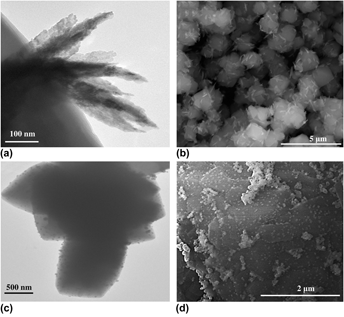Crossref Citations
This article has been cited by the following publications. This list is generated based on data provided by
Crossref.
Zhang, Peng
Dong, Zhiyuan
Ran, Yuanming
Xie, Hualin
Lu, Yun
and
Ding, Shimin
2018.
Preparation and photocatalytic application of AgBr modified Bi2WO6 nanosheets with high adsorption capacity.
Journal of Materials Research,
Vol. 33,
Issue. 23,
p.
3953.
Song, Yiming
Li, Jun
and
Wang, Chen
2018.
Modification of porphyrin/dipyridine metal complexes on the surface of TiO2 nanotubes with enhanced photocatalytic activity for photoreduction of CO2 into methanol.
Journal of Materials Research,
Vol. 33,
Issue. 17,
p.
2612.
Boruban, Cansu
and
Esenturk, Emren Nalbant
2018.
Activated carbon-supported CuO nanoparticles: a hybrid material for carbon dioxide adsorption.
Journal of Nanoparticle Research,
Vol. 20,
Issue. 3,
Goldyn, Kamila
Anfray, Clément
Komaty, Sarah
Ruaux, Valerie
Hélaine, Charly
Retoux, Richard
Valable, Samuel
Valtchev, Valentin
and
Mintova, Svetlana
2019.
Copper exchanged FAU nanozeolite as non-toxic nitric oxide and carbon dioxide gas carrier.
Microporous and Mesoporous Materials,
Vol. 280,
Issue. ,
p.
271.
Hsu, Chih-Chieh
Tsai, Jung-En
and
Lin, Yu-Sheng
2019.
A write-once-read-many-times memory based on a sol-gel derived copper oxide semiconductor.
Physica B: Condensed Matter,
Vol. 562,
Issue. ,
p.
20.
Murge, Premanath
Dinda, Srikanta
and
Roy, Sounak
2019.
Zeolite-Based Sorbent for CO2 Capture: Preparation and Performance Evaluation.
Langmuir,
Vol. 35,
Issue. 46,
p.
14751.
Li, Jing-Yu
Yuan, Lan
Li, Shao-Hai
Tang, Zi-Rong
and
Xu, Yi-Jun
2019.
One-dimensional copper-based heterostructures toward photo-driven reduction of CO2to sustainable fuels and feedstocks.
Journal of Materials Chemistry A,
Vol. 7,
Issue. 15,
p.
8676.
Ávila-López, Manuel Alejandro
Luévano-Hipólito, E.
and
Torres-Martínez, Leticia M.
2019.
CO2 adsorption and its visible-light-driven reduction using CuO synthesized by an eco-friendly sonochemical method.
Journal of Photochemistry and Photobiology A: Chemistry,
Vol. 382,
Issue. ,
p.
111933.
Olegario, Eleanor
Felizco, Jenichi Clairvaux
Pelicano, Christian Mark
Mendoza, Herman
and
Nakajima, Hideki
2020.
Philippine natural zeolite surface engineered with CuO nanowires via a one-step thermal decomposition route.
Journal of the Australian Ceramic Society,
Vol. 56,
Issue. 3,
p.
803.
Ávila-López, Manuel Alejandro
Luévano-Hipólito, E.
and
Torres-Martínez, Leticia M.
2020.
CuO coatings on glass fibers: a hybrid material for CO2 adsorption and photocatalytic reduction to solar fuels.
Journal of Materials Science: Materials in Electronics,
Vol. 31,
Issue. 16,
p.
13957.
Martínez-Vieyra, C.
Gutiérrez-Segura, E.
López-Tellez, G.
Alcántara-Díaz, D.
and
Olguín, M. T.
2021.
Antimicrobial composites of nanoparticles generated by gamma irradiation supported in clinoptilolite-rich tuff.
Applied Nanoscience,
Vol. 11,
Issue. 4,
p.
1183.
Chauhan, Ankush
Verma, Ritesh
Batoo, Khalid Mujasam
Kumari, Swati
Kalia, Rahul
Kumar, Rajesh
Hadi, Muhammad
Raslan, Emad H.
and
Imran, Ahamad
2021.
Structural and optical properties of copper oxide nanoparticles: A study of variation in structure and antibiotic activity.
Journal of Materials Research,
Vol. 36,
Issue. 7,
p.
1496.
Dhengale, Shankar D.
Rode, Chandrashekhar V.
Kolekar, Govind B.
and
Anbhule, Prashant V.
2022.
Synthesis of indeno-[1,2-b]-quinoline-9,11(6H,10H)-dione and 7,7-dimethyl-10-aryl-7,8-dihydro-5H-indeno[1,2-b]quinoline-9,11(6H,10H)-dione derivatives in presence of heterogeneous Cu/zeolite-Y as a catalyst.
RSC Advances,
Vol. 12,
Issue. 4,
p.
2083.
Cedeño Morales, Eder Moisés
Méndez-Rojas, Miguel A.
Torres-Martínez, Leticia M.
Garay-Rodríguez, Luis F.
and
Kharisov, Boris I.
2022.
Gold nanoparticle decoration of metal oxides (M = Cu, Ni, Zn) embedded in porous MOF-derived: Facile synthesis and possible applications.
Journal of Materials Research,
Vol. 37,
Issue. 3,
p.
818.
Rajendran, K.
Akash, S.
Roshni, M.
Pandurangan, N.
and
Jagadeesan, D.
2022.
CuO/CaO as a solid reducing reagent for nitroarenes: combined effect of oxygen vacancies and surface basicity.
Proceedings of the Indian National Science Academy,
Vol. 88,
Issue. 3,
p.
369.
Dong, Jipeng
Wang, Fei
Chen, Guanghui
Wang, Shougui
Ji, Cailin
and
Gao, Fei
2022.
Fabrication of nickel oxide functionalized zeolite USY composite as a promising adsorbent for CO2 capture.
Chinese Journal of Chemical Engineering,
Vol. 46,
Issue. ,
p.
207.
Huenuvil-Pacheco, I.
Jaramillo, A.F.
Abreu, N.J.
Garrido-Miranda, K.
Sánchez-Sanhueza, G.
González-Rocha, G.
Medina, C.
Montoya, L.F.
Sanhueza, J.P.
and
Melendrez, M.F.
2024.
Biocidal effects of organometallic materials supported on ZSM-5 Zeolite: Influence of the physicochemical and surface properties.
Heliyon,
Vol. 10,
Issue. 5,
p.
e27182.
Wang, Boyan
Zeng, Jing
and
He, Hanbing
2024.
Enhanced CO2 adsorption and selectivity over N2 and CH4 in UiO-67 modified by loading CuO NPs through solvent exchange.
CrystEngComm,
Vol. 26,
Issue. 9,
p.
1328.
V, Indira
and
K, Abhitha
2024.
Zeolite A/CuO embedded natural rubber foam for efficient carbon dioxide capture in the packed column.
Journal of Environmental Chemical Engineering,
Vol. 12,
Issue. 6,
p.
114842.
Zhou, Ying
Nguyen, Hang N.
Peña-Bahamonde, Janire
Robles-Hernandez, Francisco C.
Gimenes, Luciana Jandelli
and
Rodrigues, Debora F.
2024.
The role of secondary metabolites in the production of CuO nanoparticles by fungi: a physiological and metabolic approach.
Environmental Science: Nano,
Vol. 11,
Issue. 11,
p.
4487.
